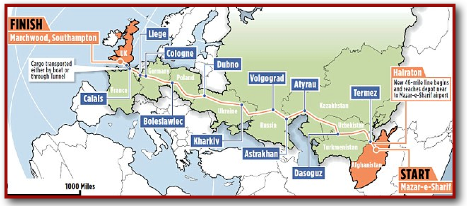My previous posting, discussed some of the implications of our looming grand-strategic defeat in Afghanistan. Here, we address the narrower logistics question of how to bring our forces home.
The old adage that it is easy to get into Afghanistan but painful to leave is true for many reasons — a big one was just described in the 27 November issue of the Daily Mirror [see attachment 1 below] — the British army plans to use Russian railways, built by the Tsars 140 years ago, to return hundreds of millions of pounds worth of equipment in Afghanistan via a landroute to the English Channel.
If you think the horror described in the Daily Mirror report is bad, think about the US options: Given our deteriorating relations with Pakistan, the long, highly vulnerable land route out of Afghanistan, thru the Bolan and Khyber passes, and then down the road system of the Indus Valley in Pakistan to the teeming and potentially violent port of Karachi, is becoming increasingly problematic.
An alternative exit strategy for redeploying the far larger US forces would be an agonizing variation of the Dunkirk option described in the Daily Mirror report plus a sea lift, perhaps via transshipment points in Black Sea ports, like Batumi in Georgia, or Novorossiysk or Sochi in southern Russia, or even Odessa in the Ukraine (which at least would avoid the intermediate transshipment problem posed by the different railroad gauges between Poland and Germany).
A more remote option would be to repair relations with the mullahs of Iran and exit overland, westward thru transshipment ports in that country; but that unlikely option would require, at a minimum, we kiss and make up with the Iranians, lift sanctions, and tell our so-called allies, the Israelis, to shut up and stop threatening to bomb Iran.
By process of elimination, therefore, the fourth and most likely exit option is the time-honored US strategy of leaving mounds of expensive equipment behind when it flies away from a war. Moreover, from the perspective of the MICC, this option has the added advantage of increasing the demand for larger budgets in the future, because it would make it easier to sell a “reset” program to replace the losses with newer, even more-expensive, more-complex, logistics-intensive weapons and equipment that are ill-suited for neutralizing the likely threats of the 21st Century.
So, as the Aussies say, ‘no worries, mate,’ because ‘tomorrow is another day,’ and besides, the MICC is likely to win by losing, after Afghanistan is gone with the wind.
Chuck Spinney
————————
Attachment 1:
The ‘new Dunkirk’ – British forces to use Tsars’ railway to travel 3,500 miles home by train from Afghanistan
By Christopher Leake and Will Stewart , Daily Mail, 27 November 2001
After a decade of war, they face the awesome task of shifting a colossal mass of hardware more than 3,500 miles across Europe to bases in Germany and the UK by the time British troops pull out in 2014.
The tally of goods used in the war against the Taliban since 2001 includes armoured vehicles, trucks, aircraft, helicopters, artillery, mortars, temporary buildings and medical centres.
British military commanders are planning to use Russian railways, built by the Tsars 140 years ago, to bring home hundreds of millions of pounds worth of equipment from Afghanistan.
To prepare for one of the biggest logistics exercises they have ever undertaken, Army, Navy and RAF chiefs have been visiting former Soviet states bordering Afghanistan to draw up a masterplan for what has been dubbed the ‘new Dunkirk’.
The idea being discussed with military and political figures in the Russian states envisages using the world’s most powerful cargo locomotives to pull up to 170 wagons along railway lines first used by the Tsars and later by Stalin. … continued



